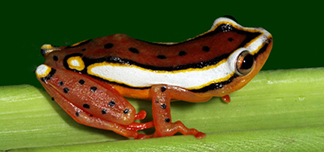You are here
Amphibians
Heleophryne Sclater, 1898
EOL Text
These are known as the Ghost frogs. There is one genus, Heleophryne, with about six species. They are small to moderate sized frogs (30-65 mm). These frogs are found in rocky montane streams in South Africa; the tips of the fingers and toes are expanded. Synapomorphies of Heleophryne include the absence of keratinous beaks in larvae, although numerous rows of denticles are present.
The family Heleophrynidae is taxonomically redundant with the single genus Heleophryne. The name Heleophryne was defined by Ford and Cannatella (1993) to be the node-based name for the common ancestor of the living species of Heleophryne, and all its descendants. Synapomorphies of Heleophryne include the absence of keratinous beaks in larvae, although numerous rows of denticles are present. No fossils have been described.
| License | http://creativecommons.org/licenses/by/3.0/ |
| Rights holder/Author | Tree of Life web project |
| Source | http://tolweb.org/Heleophryne/16942 |
Most analyses of molecular data have placed Heleophryne as the sister-group of all other Neobatrachia.
Laurent (1979, 1986) included this taxon as a subfamily of Myobatrachidae, but there seem to be no derived characters that would suggest that relationship in preference to any other.
The phylogeny in Duellman and Trueb (1986) indicated that all neobatrachians excluding myobatrachids, sooglossids, and Heleophryne formed a subclade diagnosed by the evolutionary appearance of axillary amplexus (their character P). However, they pointed out that some "leptodactylids" have inguinal amplexus, suggesting that basal leptodactylids are paraphyletic, or that the character is reversed. In reporting inguinal amplexus in all three species of sooglossids, Nussbaum (1980) reviewed the literature on amplexus position; Somuncuria, a species of Batrachyla, and some Pleurodema have inguinal amplexus. The putative position of these taxa as basal leptodactylids (Lynch, 1978) suggested that inguinal amplexus may be primitive for these taxa as well.
A photo in Halliday and Adler (1986:38-39) shows Brachycephalus ephippium in inguinal amplexus. Other cases are known in Bufonidae: Osornophryne (Ruiz-C. and Hernández-C., 1976) and Bufo fastidiosus (Graybeal and de Queiroz, 1992). These are most likely derived reversals within the Neobatrachia.
| License | http://creativecommons.org/licenses/by/3.0/ |
| Rights holder/Author | Tree of Life web project |
| Source | http://tolweb.org/Heleophryne/16942 |
| License | http://creativecommons.org/licenses/by/3.0/ |
| Rights holder/Author | Tree of Life web project |
| Source | http://tolweb.org/Heleophryne/16942 |
Barcode of Life Data Systems (BOLD) Stats
Specimen Records:7
Specimens with Sequences:7
Specimens with Barcodes:7
Species:3
Species With Barcodes:3
Public Records:3
Public Species:2
Public BINs:2
The Heleophrynidae are a family of order Anura, commonly known as ghost frogs. The family consists of a two genera, Heleophryne and Hadromophryne, with seven species. Ghost frogs live in swift-moving mountain streams in South Africa. The common name of "ghost frogs" may have been coined because of their occurrence in Skeleton Gorge.[1]
Biology[edit]
Ghost frogs have morphological adaptation suited to surviving on the rocks around these streams. They are medium-sized frogs, reaching a length of 6 cm (2.4 in), with flat bodies, enabling them to climb inside rocky crevices. They have very large toe discs in comparison to their size, which helps to cling onto rocks. The mouthparts of the tadpoles are modified into sucking discs, to allow them to cling to substrates, and remain still while they are feeding.[1]
Taxonomy[edit]
The ghost frogs are closely related to the Sooglossidae family, which inhabit the Seychelles. They may also be closely related to the Australian Myobatrachidae.
Family Heleophrynidae
- Genus Hadromophryne Van Dijk, 2008
- Natal ghost frog, Hadromophryne natalensis Hewitt, 1913
- Genus Heleophryne Sclater, 1898
- Cederberg ghost frog, Heleophryne depressa FitzSimons, 1946
- Hewitt's ghost frog, Heleophryne hewitti Boycott, 1988
- Eastern ghost frog, Heleophryne orientalis FitzSimons, 1946
- Purcell's ghost frog, Heleophryne purcelli Sclater, 1898
- Royal ghost frog, Heleophryne regis Hewitt, 1910
- Rose's ghost frog, Heleophryne rosei Hewitt, 1925
EDGE endangered species[edit]
On January 21, 2008, Evolutionarily Distinct and Globally Endangered (EDGE) identified nature's most "weird, wonderful and endangered species", stating that "the EDGE amphibians are amongst the most remarkable and unusual species on the planet and yet an alarming 85% of the top 100 are receiving little or no conservation attention." Their top ten species included the ghost frogs.[2][3][4]
References[edit]
- ^ a b Zweifel, Richard G. (1998). Cogger, H.G. & Zweifel, R.G., ed. Encyclopedia of Reptiles and Amphibians. San Diego: Academic Press. pp. 104–105. ISBN 0-12-178560-2.
- ^ Reuters, Giant newt, tiny frog identified as most at risk
- ^ guardian.co.uk, Drive to save weird and endangered amphibians
- ^ guardian.co.uk/environment, Gallery: the world's strangest amphibians
- Cogger, H.G.; R.G. Zweifel, and D. Kirschner (2004). Encyclopedia of Reptiles & Amphibians Second Edition. Fog City Press. ISBN 1-877019-69-0. Cite uses deprecated parameters (help)
| License | http://creativecommons.org/licenses/by-sa/3.0/ |
| Rights holder/Author | Wikipedia |
| Source | http://en.wikipedia.org/w/index.php?title=Ghost_frog&oldid=630938189 |

